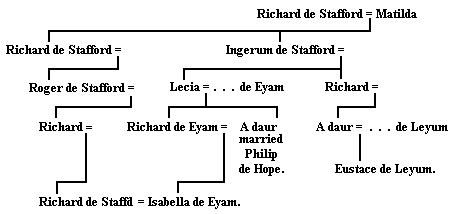Proceedings taken in Winster Church“Proceedings taken in Winster Church regarding the Consanguinity of the Parties to the Marriage of two of the Staffords of Eyam” (1308) This article was published originally in the Derbyshire Archaeological Society Journal, vol. 23, 1901; pp83-86. This transcription by Rosemary Lockie © 2001 The Production of Evidence on behalf of Richard de Stafford de Eyam touching the consanguinity which is said to exist between Richard, his son, and Isabella, his wife, taken in [Page 84] the Parish Church of Winster, on the Tuesday next after the Feast of All Saints (5 Nov.) A.D. 1308. William le Proude del Fowlowe (Foolow, near Eyam), Sexagenarian of Free Condition, having been sworn, carefully examined, and questioned, upon the libel of the accusation against those who were united, and who were present, declared that the contention in the same was true, and he says that he knows this because he is of the said kinship, and knew well all the descendants on both sides. When asked who was the (stipes) Common Ancestor, he said that a certain Richard de Stafford, who had a certain wife called Matilda, was the Common Ancestor, who had two sons named Richard and Ingeram. Richard had issue a certain Roger. From Roger proceeded Richard de Stafford. From Richard proceeded his son Richard, concerning whom was the dispute on the one side. From Ingeram proceeded a certain Lecia. Lecia had issue Richard de Eyam. From Richard proceeded Isabella, concerning whom was the dispute on the other side. When asked whether he had seen all those parties before, he said that he had, except the one who was the Highest (in the pedigree). When asked if he believed that they were relations, he said that he knew it well. When asked from who he had learnt at first that relationship, he said from his mother; that he knew it the better because Ingeram was his grandfather. When asked whether he had learnt of that relationship before the litigation was commenced, he answered that he knew it forty years before. When asked whether the said Richard pursued the litigation from love or from hate, he said he believed from love, lest the couple should continue the irregular connection. He is ignorant, however, what the accusation precisely is, and says all those persons mentioned have always regarded themselves as relations. When asked whether he is the more affected by the divorce or by the marriage between them, says he holds himself indifferent. When asked whether [Page 85] he had been induced by anybody to depose against the truth, said he had not; that he had neither been influenced nor prompted. Philip de Hope, full sixty years of age, of free condition, when carefully examined upon oath, and questioned upon his own evidence, given when examined before, says the same thing as the first witness, that he is not of the aforementioned family, but that touching the matter before them he had learnt of the said relationship from the said Lecia, whose daughter he had married. William le Chapman, of Eyam, sexagenarian of free condition, when carefully examined, etc., upon his former evidence, says the same thing as the first witness, that he had learnt the said relationship from his father and mother, but says that he had not seen the two brothers who had made the first step. Eustace de Leyun (Leam, in the parish of Eyam), sexagenarian of free condition, when examined on oath, gave the same evidence as at his former examination, and said that he had learnt of the said relationship from his mother, who was the daughter of Richard (the son of?) Ingeram, and that as regards the matter in hand, he had not seen Ingeram. Henry, the son of Richard de Geldacre, forty years of age, of free condition, examined on oath touching all the above evidence, gives the same evidence as before, but says that he had not seen the two brothers who descended from the common ancestor, nor Roger, the son of Richard. Richard del Hawe, sexagenarian, etc., gives the same evidence as Philip, at his first examination, gave touching the matter, and says that Roger and Ingeram were brothers, and that he had learnt of this relationship from his father and mother. Richard Freeman, sexagenarian, gives the same evidence as Eustace, when first examined, that he is of the said family, and that he had learnt of that relationship from his own family. Subsequent events prove that the divorce was carried out. [Page 86]PEDIGREE OBTAINED FROM ABOVE 
[Ed: This Pedigree is essentially the same as on Page 263 of the author's article on The Staffords of Eyam, the only appreciable differences being that on the latter Lecia's husband, of Eyam, is named as John, and Ingerum is spelled Ingram. Although it doesn't affect the descent, I personally find it difficult to accept "Ingerum" and "Lecia" as forenames. Could the original document's latin be subject to other interpretations?] |
|